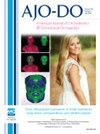前牙合手术与非手术治疗后咬合功能的变化:2年随访。
IF 3
2区 医学
Q1 DENTISTRY, ORAL SURGERY & MEDICINE
American Journal of Orthodontics and Dentofacial Orthopedics
Pub Date : 2025-05-27
DOI:10.1016/j.ajodo.2025.04.025
引用次数: 0
摘要
简介:前牙交叉咬合(ACB)导致功能障碍,如咀嚼效率降低,由于不正确的前牙咬合。本研究评估了ACB治疗对咬合力(of)和咬合接触面积(OCA)的影响,重点是前牙、后牙和全牙。方法:回顾性研究122例女性患者,年龄18 ~ 40岁,分为伪装组(n = 32)、手术组(n = 34)、对照组(n = 56)。分别在治疗前、治疗后和治疗后2年使用牙科预分系统测量OF和OCA。同时获得侧位头颅造影以评估骨骼和牙齿的变化。结果:ACB组患者包括伪装组和手术组在T0时均较对照组出现下前路OF和OCA (P)。结论:ACB组患者有下前路OF和OCA,但经非手术正畸伪装治疗后有所升高。相比之下,严重骨骼III类错颌和ACB患者的后侧OCA和总OCA较低,正颌手术后的OCA与非手术患者相同。通过这些治疗,患者可以在前牙和后牙之间获得更平衡的咬合。本文章由计算机程序翻译,如有差异,请以英文原文为准。
Changes in occlusal function after surgical and nonsurgical treatment of anterior crossbite: A 2-year follow-up
Introduction
Anterior crossbite (ACB) leads to functional impairments, such as reduced masticatory efficiency because of improper occlusion of the anterior teeth. This study evaluated how treatment of ACB affected the occlusal force (OF) and occlusal contact area (OCA), focusing on anterior, posterior, and total teeth.
Methods
This retrospective study included 122 female patients aged 18-40 years, divided into 3 groups: camouflage (n = 32), surgery (n = 34), and control (n = 56). The OF and OCA were measured using the Dental Prescale System before treatment, immediately after treatment, and 2 years after treatment. Lateral cephalograms were obtained simultaneously to evaluate skeletal and dental changes.
Results
The patients with ACB, including camouflage and surgery groups, showed lower anterior OF and OCA than the control group at T0 (P <0.01). However, after treatment, the 3 groups showed no significant differences. The surgery group showed lower total OCA than the control group before treatment and 2 years after treatment (P <0.05). Before treatment, the camouflage and surgery groups showed lower anterior/total ratios of the OF and OCA than the control group (P <0.001), but the ratios improved after treatment.
Conclusions
Patients with ACB had lower anterior OF and OCA, but these increased after nonsurgical orthodontic camouflage treatment. In contrast, patients with severe skeletal Class III malocclusion and ACB had lower posterior OCA and total OCA, which increased as much as those in the nonsurgical patients after orthognathic surgery. Through these treatments, patients can obtain a more balanced occlusion between the anterior and posterior teeth.
求助全文
通过发布文献求助,成功后即可免费获取论文全文。
去求助
来源期刊
CiteScore
4.80
自引率
13.30%
发文量
432
审稿时长
66 days
期刊介绍:
Published for more than 100 years, the American Journal of Orthodontics and Dentofacial Orthopedics remains the leading orthodontic resource. It is the official publication of the American Association of Orthodontists, its constituent societies, the American Board of Orthodontics, and the College of Diplomates of the American Board of Orthodontics. Each month its readers have access to original peer-reviewed articles that examine all phases of orthodontic treatment. Illustrated throughout, the publication includes tables, color photographs, and statistical data. Coverage includes successful diagnostic procedures, imaging techniques, bracket and archwire materials, extraction and impaction concerns, orthognathic surgery, TMJ disorders, removable appliances, and adult therapy.

 求助内容:
求助内容: 应助结果提醒方式:
应助结果提醒方式:


